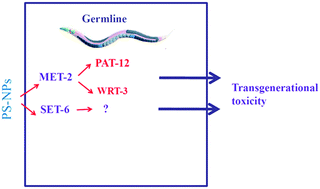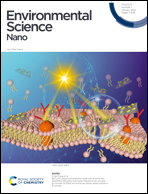Increase in germline methyltransferases governing the methylation of histone H3K9 is associated with transgenerational nanoplastic toxicity in Caenorhabditis elegans†
Abstract
In Caenorhabditis elegans, long-term exposure to 20 nm polystyrene nanoparticles (PS-NPs) caused transgenerational toxicity. However, the underlying mechanisms for induction of this transgenerational PS-NP toxicity remain largely unknown. We here determined the role of germline histone methyltransferases (HMTs) in controlling transgenerational PS-NP toxicity in nematodes. Among the germline genes encoding HMTs, PS-NP (1–100 μg L−1) exposure dysregulated met-2, ttll-12, set-5, set-6, set-12, and set-23 expressions. Among the germline genes encoding HMTs, only germline RNAi knockdown of met-2 and set-6, two genes required for methylation of H3K9, affected PS-NP toxicity at the P0 generation. Additionally, PS-NP exposure resulted in a transgenerational increase in the expressions of met-2 and set-6, and the transgenerational PS-NP toxicity was prevented in met-2(RNAi) and set-6(RNAi) nematodes. Therefore, an increase in the expression of MET-2 and SET-6, two HMTs required for methylation of H3K9, mediated the induction of transgenerational toxicity after PS-NP exposure. Moreover, in germline cells, MET-2 regulated the transgenerational PS-NP toxicity by increasing the expression and function of two downstream targets, PAT-12 and WRT-3, which provided an important basis for germline MET-2 in controlling transgenerational PS-NP toxicity in nematodes.

- This article is part of the themed collection: Best Papers 2022 – Environmental Science: Nano


 Please wait while we load your content...
Please wait while we load your content...